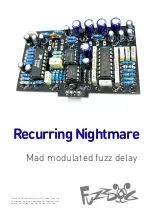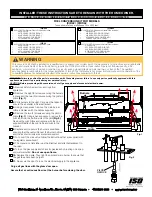
The power and signal pads on the PCB conform
to the FuzzDog Direct Connection format, so
can be paired with the appropriate
daughterboard for quick and easy offboard
wiring. Check the separate daughterboard
document for details.
If you aren’t using sockets for the ICs (why not?)
be extra careful and take your time soldering
them. They’re very easily to fry with heat.
You should solder all other board-mounted
components before you solder the pots. Once
they’re in place you’ll have no access to much of
the board. Make sure your pots all line up nicely.
The best way to do that is to solder a single pin
of each pot in place then melt and adjust if
necessary before soldering in the other two
pins. Same for the toggle switch. If your pots
don’t have protective plastic jackets ensure
you leave a decent gap between the pot body
and the PCB otherwise you risk shorting out
the circuit.
Snap the small metal tag off the pots so they
can be mounted flush in the box.
9V or 18V supply?
The circuit works best at 18V, so we’ve included
an on-board charge pump so you can achieve
this with a 9V supply. If you’d rather use a
dedicated 18V supply you can leave out all the
charge pump parts (marked in green on the
BOM) and add a jumper as shown in red above.
U1 will still drop the voltage going to the PT2399
to the required 5V.
PCB layout ©2019 Pedal Parts Ltd.
Summary of Contents for Recurring Nightmare
Page 4: ......


























